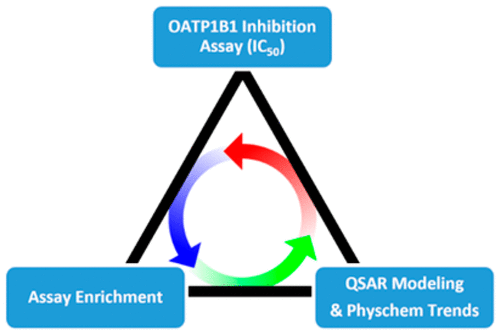当前位置:
X-MOL 学术
›
Mol. Pharmaceutics
›
论文详情
Our official English website, www.x-mol.net, welcomes your feedback! (Note: you will need to create a separate account there.)
In Silico and in Vitro Assessment of OATP1B1 Inhibition in Drug Discovery
Molecular Pharmaceutics ( IF 4.9 ) Pub Date : 2018-06-21 00:00:00 , DOI: 10.1021/acs.molpharmaceut.8b00168 Matthew L. Danielson , Geri A. Sawada , Thomas J. Raub , Prashant V. Desai
Molecular Pharmaceutics ( IF 4.9 ) Pub Date : 2018-06-21 00:00:00 , DOI: 10.1021/acs.molpharmaceut.8b00168 Matthew L. Danielson , Geri A. Sawada , Thomas J. Raub , Prashant V. Desai

|
The organic anion-transporting polypeptide 1B1 transporter belongs to the solute carrier superfamily and is highly expressed at the basolateral membrane of hepatocytes. Several clinical studies show drug–drug interactions involving OATP1B1, thereby prompting the International Transporter Consortium to label OATP1B1 as a critical transporter that can influence a compound’s disposition. To examine OATP1B1 inhibition early in the drug discovery process, we established a medium-throughput concentration-dependent OATP1B1 assay. To create an in silico OATP1B1 inhibition model, deliberate in vitro assay enrichment was performed with publically known OATP1B1 inhibitors, noninhibitors, and compounds from our own internal chemistry. To date, approximately 1200 compounds have been tested in the assay with 60:40 distribution between noninhibitors and inhibitors. Bagging, random forest, and support vector machine fingerprint (SVM-FP) quantitative structure–activity relationship classification models were created, and each method showed positive and negative predictive values >90%, sensitivity >80%, specificity >95%, and Matthews correlation coefficient >0.8 on a prospective test set indicating the ability to distinguish inhibitors from noninhibitors. A SVMF-FP regression model was also created that showed an R2 of 0.39, Spearman’s rho equal to 0.76, and was capable of predicting 69% of the prospective test set within the experimental variability of the assay (3-fold). In addition to the in silico quantitative structure–activity relationship (QSAR) models, physicochemical trends were examined to provide structure activity relationship guidance to early discovery teams. A JMP partition tree analysis showed that among the compounds with calculated logP >3.5 and ≥1 negatively charged atom, 94% were identified as OATP1B1 inhibitors. The combination of the physicochemical trends along with an in silico QSAR model provides discovery project teams a valuable tool to identify and address drug–drug interaction liability due to OATP1B1 inhibition.
中文翻译:

药物发现中OATP1B1抑制的计算机模拟和体外评估
有机阴离子转运多肽1B1转运蛋白属于溶质载体超家族,在肝细胞的基底外侧膜上高表达。几项临床研究表明,涉及OATP1B1的药物相互作用,因此促使国际转运蛋白联盟将OATP1B1标记为可能影响化合物处置的关键转运蛋白。为了在药物发现过程的早期检查OATP1B1的抑制作用,我们建立了中等通量浓度依赖性OATP1B1测定法。为了创建计算机模拟的OATP1B1抑制模型,使用公知的OATP1B1抑制剂,非抑制剂和我们自己内部化学的化合物进行了有意的体外测定富集。迄今为止,该试验已测试了约1200种化合物,其中60种为:非抑制剂和抑制剂之间的40分布。建立了套袋,随机森林和支持向量机指纹(SVM-FP)定量结构-活动关系分类模型,每种方法均显示阳性和阴性预测值> 90%,灵敏度> 80%,特异性> 95%和Matthews前瞻性测试集上的相关系数> 0.8,表明有能力区分抑制剂和非抑制剂。还创建了一个SVMF-FP回归模型,该模型显示了 前瞻性测试集上的图8显示了区分抑制剂和非抑制剂的能力。还创建了一个SVMF-FP回归模型,该模型显示了 前瞻性测试集上的图8显示了区分抑制剂和非抑制剂的能力。还创建了一个SVMF-FP回归模型,该模型显示了R 2为0.39,Spearman的rho等于0.76,并且能够预测该试验的实验变异性(3倍)内的前瞻性测试集的69%。除了计算机定量结构-活性关系(QSAR)模型之外,还检查了理化趋势,以为早期发现团队提供结构活性关系指导。JMP分区树分析表明,在计算logP> 3.5和≥1的带负电原子的化合物中,有94%被鉴定为OATP1B1抑制剂。物理化学趋势与计算机模拟QSAR模型相结合,为发现项目团队提供了一种有价值的工具,用于识别和解决由于OATP1B1抑制而引起的药物相互作用。
更新日期:2018-06-21
中文翻译:

药物发现中OATP1B1抑制的计算机模拟和体外评估
有机阴离子转运多肽1B1转运蛋白属于溶质载体超家族,在肝细胞的基底外侧膜上高表达。几项临床研究表明,涉及OATP1B1的药物相互作用,因此促使国际转运蛋白联盟将OATP1B1标记为可能影响化合物处置的关键转运蛋白。为了在药物发现过程的早期检查OATP1B1的抑制作用,我们建立了中等通量浓度依赖性OATP1B1测定法。为了创建计算机模拟的OATP1B1抑制模型,使用公知的OATP1B1抑制剂,非抑制剂和我们自己内部化学的化合物进行了有意的体外测定富集。迄今为止,该试验已测试了约1200种化合物,其中60种为:非抑制剂和抑制剂之间的40分布。建立了套袋,随机森林和支持向量机指纹(SVM-FP)定量结构-活动关系分类模型,每种方法均显示阳性和阴性预测值> 90%,灵敏度> 80%,特异性> 95%和Matthews前瞻性测试集上的相关系数> 0.8,表明有能力区分抑制剂和非抑制剂。还创建了一个SVMF-FP回归模型,该模型显示了 前瞻性测试集上的图8显示了区分抑制剂和非抑制剂的能力。还创建了一个SVMF-FP回归模型,该模型显示了 前瞻性测试集上的图8显示了区分抑制剂和非抑制剂的能力。还创建了一个SVMF-FP回归模型,该模型显示了R 2为0.39,Spearman的rho等于0.76,并且能够预测该试验的实验变异性(3倍)内的前瞻性测试集的69%。除了计算机定量结构-活性关系(QSAR)模型之外,还检查了理化趋势,以为早期发现团队提供结构活性关系指导。JMP分区树分析表明,在计算logP> 3.5和≥1的带负电原子的化合物中,有94%被鉴定为OATP1B1抑制剂。物理化学趋势与计算机模拟QSAR模型相结合,为发现项目团队提供了一种有价值的工具,用于识别和解决由于OATP1B1抑制而引起的药物相互作用。



























 京公网安备 11010802027423号
京公网安备 11010802027423号